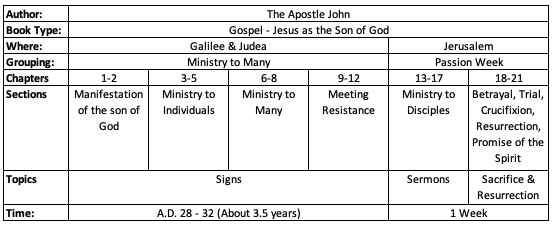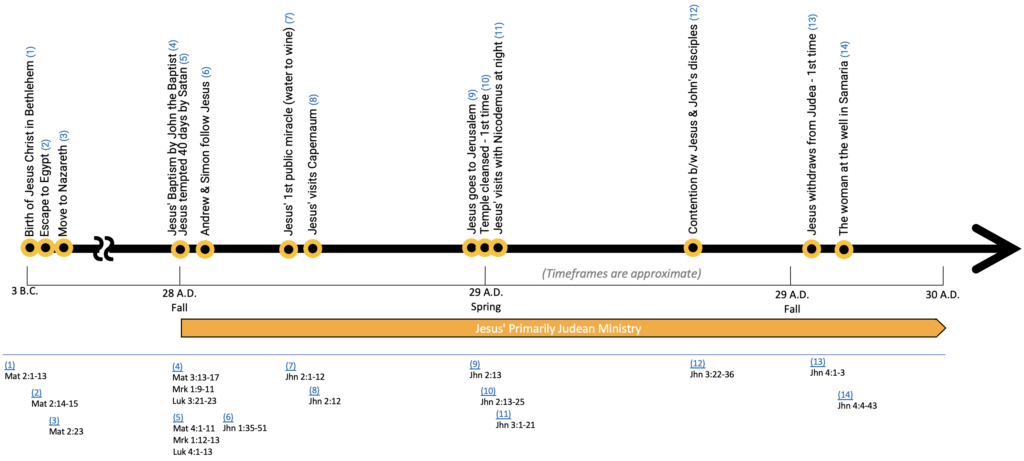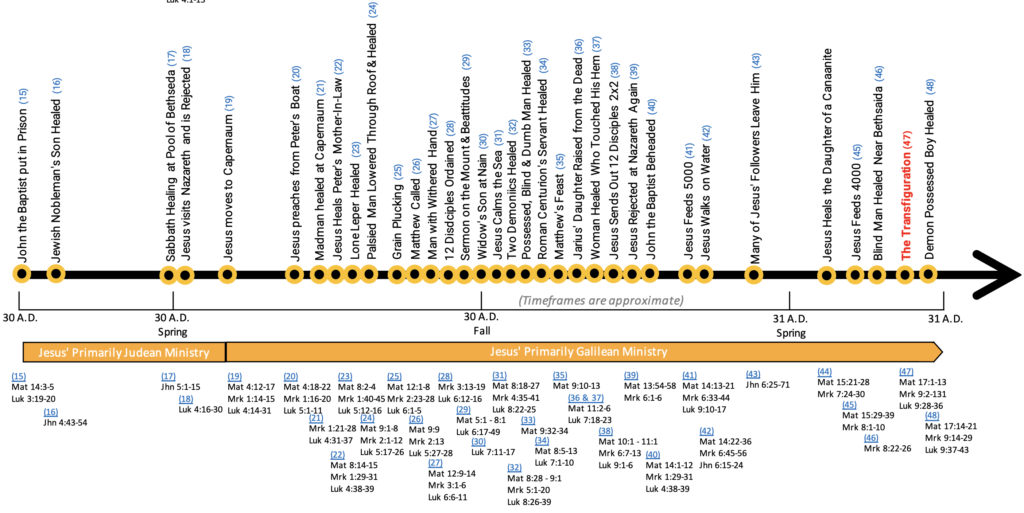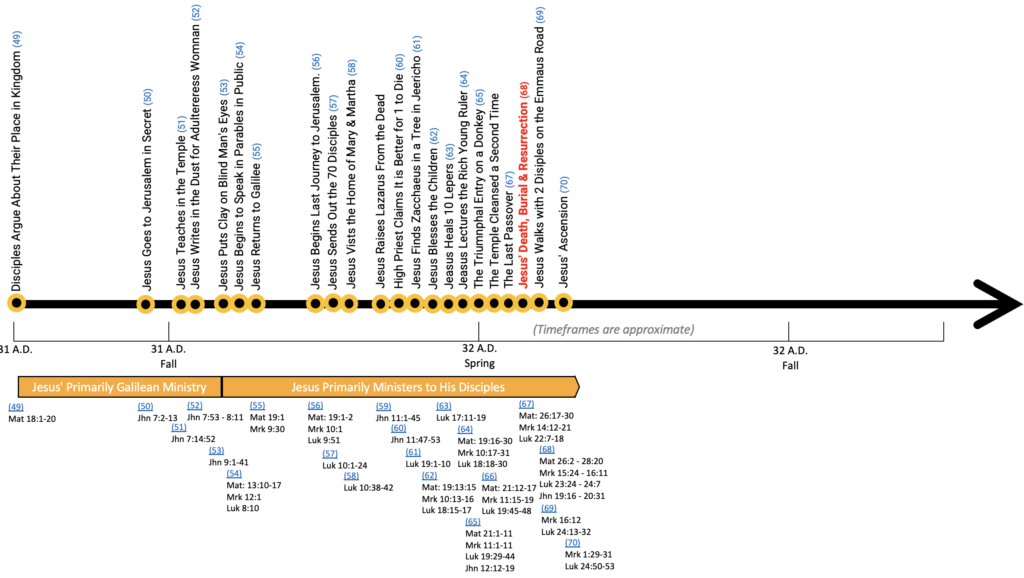John
The Gospel of Jesus Christ - "Son of God"
Summary | About | Why You Should Read it | Author | When Written | Context | Timeline | Location | Outline | Observations | Resources
Summary
The Gospel of John presents Jesus as the Son of God. It provides Jesus’ lineage from a spiritual perspective in John 1:1-3, which explains that He is pre-existent and “All things were made through Him, and without Him nothing was made that was made.” This gospel focuses on the spiritual perspective. Its intended audience is the church.
This book covers the ministry of Jesus and ends after His resurrection with the promise of His return, setting up John’s sequel, the Book of Revelation.
The next table is a high-level look at the structure and contents of this gospel.

About
The gospel of John is the fourth of four gospels and the fourth book of the New Testament. The last half of the book is dedicated to what is referred to as the “Passion Week”, or the last week before His crucifixion.

Why You Should Read It
John presents Jesus in a very different way than the other three gospels. Coming from the spiritual perspective, demonstrating how He is the Son of God, John includes details that are not mentioned anywhere else. He describes six miracles not covered in the other gospels. They are outlined below.
Six Miracles Only Recorded in John
- Jesus tuns water into wine – Jhn 2:1-11
- Jesus Heals an Official’s Son Remotely – Jhn 4:46-54
- Jesus Heals a Lame Man at Bethesda pool – Jhn 5:1-15
- Jesus Heals a Man Born Blind – Jhn 9:1-41
- Jesus Raises Lazarus from the Dead – 11:1-45
- Second Miraculous Catch of Fish – Jhn 21:1-14
John also provides insight into the early ministry of Jesus including His first miracle performed, turning the water into wine at the wedding at Cana.
John only has one parable of Jesus, but it is only recorded in John. That is the parable of “The Sheep, Shepherd, and Gate”.
The table below shows how the Book of John differs and compares to the other gospels.

Author
The Author of this gospel is the apostle John, brother of James, son of Zebedee and Salome. He and his brother James were likely the followers of John the Baptist that were one of the first to follow after Jesus, as described in John 1:19-61. They were both fisherman from the area of Galilee. Jesus gave these two a particular nickname, the “sons of thunder” (Mark 3:17).
John was one of the inner circle of the 12 Apostles. John was usually one of the smaller group that was able to be with Jesus at His more intimate gatherings, such as at the Transfiguration or when Jesus answered their questions on the Mount of Olives regarding the end-times.
John is credited with the writing of five of the New Testament books, second only in number to Paul (who wrote 13, probably 14). John wrote not only this gospel, but also 3 epistles (I John, II John and III John) and also what is considered by many to be the sequel to this gospel, the Book of Revelation.
When Written
Likely written between A.D. 60 – 95. There is a strong suspicion that the gospel was written after John received the Revelation of Jesus Christ, which would put it around A.D. 95.
Context
John was writing this gospel around the time of or shortly after the Roman siege and eventual destruction of Jerusalem. This persecution continued on for the remainder of John’s life and well beyond.
This account of the life of Jesus was written at a time when there was great persecution of the early church by both the unbelieving Jews and the Romans. This message was considered heretical to the unbelieving Jews and tyranny to the Romans. As such, the church of the day was primarily underground, in private homes. Church gatherings were starting up due to the popularity of the message and the first-hand experience of many believers that were present for Jesus’ sermons and post-resurrection showing.
There are some conjectures that it may have been written near the end of John’s life, perhaps after he received the Revelation from Jesus. This cannot be known for certain at this time, but it is an interesting possibility that could help provide some context as to John’s full understanding of Jesus as the Son of God.
Timeline
The timeframe for the gospel of John starts with Jesus’s ministry and ends after His resurrection, about a 3½ year period. A general sequence of events of the four gospels is provided below.
Location
Jesus’ ministry took place within what today is considered Israel. At the time, parts of it were controlled by gentiles, such as Samaria. The map below details the areas of His ministry. He did cross over the Jordan and preach west of Israel and also as far north as Tyre, which is in Lebanon today.

Outline
Prologue: The Word Became Flesh (1:1-18)
The Beginning of Jesus’ Ministry (1:19-51)
John the Baptist’s Testimony about Jesus (1:19-34)
John’s Disciples Follow Jesus (1:35-42)
Jesus Calls Philip and Nathanael (1:43-51)
Jesus’ Public Ministry: Signs and Discourses (chs. 2-11)
Changing Water into Wine (2:1- 11)
Cleansing the Temple (2:12-25)
Jesus Teaches Nicodemus (3:1- 21)
John the Baptist’s Final Testimony about Jesus (3:22-36)
Jesus and the Samaritans (4:1- 42)
Healing of the Official’s Son (4:43-54)
Jesus’ Visit to Jerusalem at an Annual Feast (ch. 5)
Feeding the 5,000 and Jesus’ Claim to Be the Bread of Life (ch. 6)
Jesus at the Feast of Tabernacles and Disputes over Who He Is (chs. 7-8)
Healing of the Man Born Blind (ch. 9)
Jesus is the Good Shepherd (10:1-21)
Conflict at the Feast of Dedication over Jesus’ Identity (10:22-42)
The Raising of Lazarus (ch. 11)
The Passion Week (chs.12-19)
The Anointing of Jesus’ Feet (12:1-11)
Jesus’ Entry into Jerusalem as King (12:12-19)
Jesus Predicts His Death (12:20-36)
Belief and Unbelief among the Jews (12:37-50)
Jesus’ Farewell Discourses and Prayer (chs. 13-17)
At the Last Supper (chs. 13-14)
Jesus washes the disciples’ feet (13:1-17)
Jesus predicts his betrayal (13:18-30)
Jesus predicts Peter’s denial (13:31-38)
Jesus comforts his disciples (14:1-4)
Jesus is the way to the Father (14:5-14)
Jesus promises the Holy Spirit (14:15-30)
On the way to Gethsemane (chs. 15-16)
The vine and the branches (15:1-17)
The world hates the disciples (15:18-25)
The work of the Holy Spirit (15:26;16:15)
The disciples’ grief will turn to joy (16:16-33)
Jesus’ prayer (ch. 17)
For himself — that he be glorified (17:1-5)
For his disciples (17:6- 19)
For all believers (17:20- 26)
Jesus’ Betrayal and Arrest (18:1- 11)
Jesus’ Trials before Jewish and Roman Officials (18:12-40)
Jesus’ Crucifixion (19:1-27)
Jesus’ Death and Burial (19:28-42)
Jesus’ Resurrection (20:1-29)
Statement of the Gospel’s Purpose (20:30-31)
Epilogue: Jesus’ Recommissioning of the Disciples (ch. 21)
Observations
- In Mark 3:17, Jesus nicknamed John and his brother James, “Sons of Thunder.”
- John was the son of Zebedee and Salome.
- It appears that John was a disciple of John the Baptist until he was called to follow Jesus at the outset of the Lord’s ministry. 1:19-61
- John is mentioned three times in the Book of Acts, and each time it is association with Peter. Acts 3:1; 4:13; 8:14
- According to Revelation 1:9, John was exiled to the Island of Patmos by the Romans.
- John is identified as the dsiciple “whom Jesus loved.”
- Tradition says that John later lived in Ephesus.
- John was second only to Paul in the number of New Testament books written. John authored five of the New Testament:
- John
- 1 John
- 2 John
- 3 John
- Revelation
- John was probably the last surviving apostle.
- John’s purpose in writing is stated in John 20:31 – “. . . That you may believe that Jesus is the Christ, the Son of God, and that believing you may have life in His name.”
- Concerning the first four books of the New Testament:
- Matthew wrote for a Jewish audience.
- Mark wrote for a Roman audience.
- Luke wrote for a Greek audience.
- John wrote for the Church.
- John focuses on the meanings of the Lord’s actions rather than the actions themselves.
- The Book of John is topical rather than being so much chronological.
- The deity of Christ can be seen in the seven “I am” statements of Christ.
- John 6:35, 48 – “I am the bread of life.”
- John 8:12; 9:5 – “I am the light of the world.”
- John 10:7, 9 – “I am the door.”
- John 10:11, 14 – “I am the good shepherd.”
- John 11:25 – I am the resurrection and the life.”
- John 14:6 – “I am the way, the truth, and the life.”
- John 15:1- – “I am the vine.”
- In the Book of John, Christ refers to “the Father” more than 100 times.
Sections in John
- Deity 1:1-1:13
- God-Man 1:14-4:54
- Ministry 5-12
- Discourse 13-17
- Trials and Death 18-19
- Empty Tomb 20
- Assurance 21
Theme
- Salvation comes only through Jesus Christ, the Son of God.
- The focus is on Jesus as God. It is about His divinity.
- John focuses about half of this gospel to the Passion Week, focusing on His death and resurrection.
- John brings the promises of Jesus’ return, setting up his sequel, Revelation.
Jesus in John
- Jesus is the Christ, the Son of God, the way, the truth, and the life who alone is the revelation of God and salvation for all people (1:1-18; 20:31).



